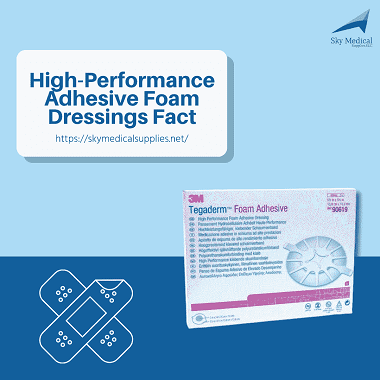
Wound dressing is considered a crucial part of wound healing. Any skin injury, major or minor, needs a certain degree of moisture to improve the process. Transparent film dressing is one of the common and effective types of wound dressing that maintain and retain water.
There are several options available when it comes to wound bandages. Each patient requires a different form of dressing depending on the severity and nature of the wound. Along with improving wound healing, these modern dressings help prevent wound infection, break down the damaged tissues, and reduce associated pain.
What Do You Know About Transparent Film Dressing Frame Style?
Made of Polyurethane membrane, transparent dressing is known for its see-through appearance. The sheet is permeable to water and small molecules but does not let larger molecules, such as bacteria, pass through it.
The dressing is self-adhesive and does not bind to the wound's margins, preventing adhesive trauma. These suit the best for low to moderate exuding wounds as transparent film dressing does not have absorptive capacity.
Examples of such dressings are Cutifilm, Tegaderm, Bioclusive, and others.
Where to Apply a transparent film Dressing?
Transparent film dressing is not used for wounds with heavy secretions. Following are examples of transparent film dressing that is beneficial.
- Protective eyelid coverings
- To cover and protect I.V. catheter sites
- Superficial dermal ulcers
- Infected wounds
- Minor burns
- Lacerations
- Superficial wounds
- Little to moderate pressure ulcers
- Post-tattoo application and removal
How to effectively apply a Film Dressing
Applying the wound dressing in the right way leads to the desired results of wound healing in time. Below given are the steps to use the film dressing:
- Wash your hands and wear a new pair of gloves
- Clean the skin injury site with saline solution or cleanser as instructed.
- Pat dry the area around the wound with a gauze pad.
- After cleaning and drying, apply a liquid barrier film to the wound to protect it from wound exudate. Defatting the skin with alcohol is also suggested to enhance film adherence.
- Apply wound filler or packing material for deep wounds.
- Peel the safety liner from the dressing to expose the adhesive section.
- Carefully apply the dressing to the wound in the center. Avoid stretching the dressing during application.
- Gently smooth the dressing from center to outwards.
- Ensure that the film dressing is one inch larger than the wound. Also, check the recommendation from the manufacturer as some dressings require a border of 2 inches.
- Remove the waste and discard the gloves.
Based on the manufacturer's recommendation, dressing changes' frequency could differ. Usually, it lasts for 3-5 days and may be up to 7 days. In case of any leakages, skin redness, or irritation, remove the dressing and check if it's the right one or not.
Benefits of Using Transparent Film Dressing
The immense benefits of a transparent film dressing to help heal a skin injury cannot be overlooked. Here are a few advantages for which transparent dressing is a choice of health care professionals.
Reduce Infection ChancesBacterial infection hinders the normal recovery process and may cause the wound to get even worse.
A dressing that acts as a protective barrier against external bacteria for skin injuries can reverse such a situation. With the fast healing rates of the film dressing and lower risk of getting an infection, the patient recovers early.
- Better Wound Visualization
For critical skin injury, the health care professional should examine the wound. Transparent film dressing allows the physician to assess the wound healing process easier and helps make necessary changes if needed.
- Enhanced Moisture
Transparent dressing is a good choice for low exudate wounds, which plays a critical role in inducing the breakdown of damaged tissues, followed by the growth of healthy tissues.
The exudate released from the wound facilitates creating a moist environment which induces a faster healing process by replacing injured skin with a healthier one.
- Protect from External Trauma
An uncovered wound is more prone to getting friction and skin injuries.
A transparent film dressing prevents more skin injury by providing a barrier between the wound and its surroundings.
This keeps the wound safe from usual scratches, rubbing, and friction.
- Used as Additional Dressing
The secondary dressing directly impacts the effectiveness of the primary dressing. Transparent film dressing can be used as a primary and secondary dressing.
As a secondary dressing, the chief role of this dressing is to protect and cover the primary dressing. Healthcare professionals usually prescribe the dressing most suitable for the patient's need.
Precautions and Considerations with Transparent film dressing
There are a few factors to consider while applying transparent film dressing.
- The dressing cannot be used for patients with heavy exudate, third-degree burns, active infection, or active herpetic lesions.
- For patients with fragile skin, such as the elderly or patients using steroids, the use of transparent film dressing is not suggested to avoid adhesive trauma.
- It is better if the dressing is not used for children.
- There should be no bleeding at the wound site before applying the dressing.
- Ointments with polyethylene compromise the adhesive nature of the dressing.
- Re-sterilizing the film dressing from E beam or steam may cause some problems.
Removing Transparent Film Dressing
Removing a film dressing does not always require a healthcare professional, but it can also be removed easily at home.
Lift the corners of the dressing and start stretching it towards the center. When two sides of the dressing remove partially, hold the dressing and continue extending horizontally until the entire dressing removes.
It is better to be careful to prevent adhesive trauma, especially if it's a severe wound. Contact the professional in case the patient needs external help. This will facilitate in protecting the damage from any undesired skin abrasion.